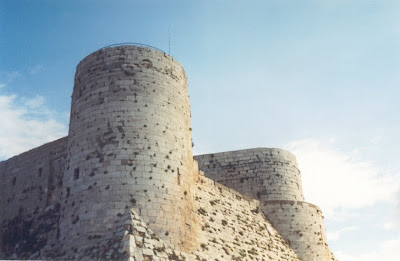The greatest of all Crusader castles was the Krak de Chevaliers, in modern day Syria. It guarded the main mountain pass leading to the Muslim city of Homs. It sits atop a 650-meter-high hill along the only route from Antioch to Beirut and the Mediterranean Sea. Crusaders captured the site in 1110 and handed it over the Knights Hospitallers, an order of militant monks. The Hospitallers upgraded the defenses constantly and it is today the one of the best surviving examples of Crusader architecture.
The Krak de Chevaliers was invested several times and did not fall until 1271, shortly before the collapse of the Crusader States in the Holy Land.



 Many of the greatest defensive architectural ideas are seen in the ruins of the Krak. It has what is known as keep-centric construction, where the keep, the last bastion of the castle is in the center and can be reached from all the other defensive areas. This allows the defense to be continued even of the outer wall is breached. Notice the angled walls on the outer towers. This makes them immensely strong, less likely to be seriously damaged by siege engines of the day. It would also give the walls strength to avoid being undermined by enemy engineers or damaged in an earthquake, a common occurrence in the Middle East. The outer wall is close to 100 feet thick on the south side. It has seven guard towers that are more than 30 feet in diameter.
Many of the greatest defensive architectural ideas are seen in the ruins of the Krak. It has what is known as keep-centric construction, where the keep, the last bastion of the castle is in the center and can be reached from all the other defensive areas. This allows the defense to be continued even of the outer wall is breached. Notice the angled walls on the outer towers. This makes them immensely strong, less likely to be seriously damaged by siege engines of the day. It would also give the walls strength to avoid being undermined by enemy engineers or damaged in an earthquake, a common occurrence in the Middle East. The outer wall is close to 100 feet thick on the south side. It has seven guard towers that are more than 30 feet in diameter.


 The Krak de Chevaliers was besieged by the two greatest Muslim Generals of the Crusades period, Nur-ad-din and Saladin. Both failed to take it. Its archectural success were copied by Edward the I of England who saw the castle while on the Ninth Crusade in 1272 and copied it in his many castle on England and Wales.
The Krak de Chevaliers was besieged by the two greatest Muslim Generals of the Crusades period, Nur-ad-din and Saladin. Both failed to take it. Its archectural success were copied by Edward the I of England who saw the castle while on the Ninth Crusade in 1272 and copied it in his many castle on England and Wales.


No comments:
Post a Comment